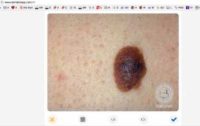17 May SKINDER App Teaches Intuitive Visual Diagnosis of Melanoma
MedicalResearch.com Interview with:
Michael S. Kolodney, MD, PhD
Section of Dermatology, Department of Medicine
West Virginia University
MedicalResearch.com: What is the background for this study? What are the main findings?
Response: Melanoma is easily curable if recognized early. Dermatologists are good at spotting melanomas because they develop an innate sense of how melanomas appear after examining thousands of malignant and benign lesions. In contrast, most medical students are relatively disadvantaged by their limited dermatology exposure. We felt that too little experience, rather than lack of knowledge of the rules, is the primary barrier to development of pattern-recognition and intuition as a reliable tool for melanoma diagnosis in non-experts. To remedy this problem, we developed a novel web-based application to mimic the training of a dermatologist by teaching medical students intuitive melanoma diagnosis in a highly condensed period of time.
Our application, which we call Skinder, teaches intuitive visual diagnosis of melanoma by quickly presenting the learner with thousands of benign and malignant skin lesions. The user makes rapid binary decisions, by swiping right for benign or left for malignant, and receives instant feedback on accuracy. With this application, the learner can amass a mental repository of diagnostic experience in a short amount of time. To determine if intuitive visual diagnosis training is superior to a traditional rule-based approach, we compared our web-based application to a rules based approach, the publicly available INFORMED Skin Education Series.
Medical students were tested on the ability top differentiate melanomas from benign pigmented lesions before and after training with either Skinder of the Informed Skin Education Series. The pre-test mean for the Skinder group was 75% correct, compared to 74.7% correct for the INFORMED group. The post-test mean for the skinder application group was 86.3% correct, compared to 77.5% correct for the INFORMED group which was highly signifcant.
MedicalResearch.com: What should readers take away from your report?
Response: As students, we are often taught to make visual diagnostic decisions based on rules but in the real world we often use a more intuitive approach based on experience. Teaching students an intuitive approach may improve their visual diagnostic skills.
MedicalResearch.com: What recommendations do you have for future research as a result of this work?
Response: We are testing if Skinder is useful for other providers such as nurses or even for patients at risk for melanoma.
MedicalResearch.com: Is there anything else you would like to add?
Response: We would like to make our application available for free for Apple and android devices. We welcome anyone who would like to contribute images of melanomas and benign pigmented lesions.
Citation:
[wysija_form id=”3″]
The information on MedicalResearch.com is provided for educational purposes only, and is in no way intended to diagnose, cure, or treat any medical or other condition. Always seek the advice of your physician or other qualified health and ask your doctor any questions you may have regarding a medical condition. In addition to all other limitations and disclaimers in this agreement, service provider and its third party providers disclaim any liability or loss in connection with the content provided on this website.
Last Updated on May 17, 2018 by Marie Benz MD FAAD

